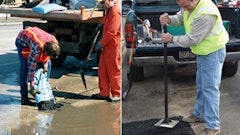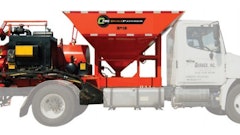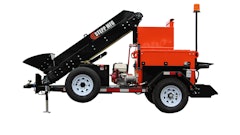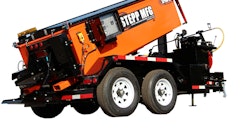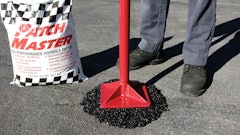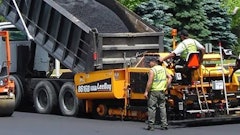
The winter freezing cycles and spring rains can cause weak spots in our pavement, often in the form of potholes. Patching potholes should be considered ‘urgent’. They can pose a real safety hazard to vehicles – especially motorcycles and bicycles, and left unrepaired, they pose a big liability for the roadway owner. So repairing them should be a very high priority. Also, unrepaired potholes are very conspicuous to the pubic, so bad for PR.
Typical Pothole
Fortunately, there are some excellent ‘quick patch’ products for making simple and immediate repairs to hazardous potholes. They usually produce good service life and excellent ‘bang for the buck’. These special cold mix products use small, high quality aggregate and proprietary asphalt binders to produce a very sticky mass that will adhere well and stay put in smaller, deeper potholes and small patches – even in the presence of water.
But be careful… trying to use them as patches in larger, less confined areas will usually lead to their displacement /movement, and their rutting or shoving out of the patch area. But in the proper application, with only minimal compaction via a hand tamper or a truck tire, these products densify to form a strong cohesive mass. A light sanding of the surface will help them blend in for aesthetics and prevent any pick-up or tracking of the asphalt binder. But always be sure to sweep up any excess sand, as it can become a slip / skid hazard – especially to motorcycles.
Various brands of quick-patch products are available – some even at the local home stores in 40-50 lb. bags. A few bags of these special materials in the back of a maintenance pickup can make everyone a pothole patcher. The products are also available in bulk for stockpiling.
Of course, conventional hot mix asphalt (HMA) can also be used for patching potholes, as long as it can be kept hot . This will usually require a heated HMA trailer or patcher truck. Another helpful resource for a road agency is establishing a special ‘pothole hotline’ where citizens can report problems.
Larger "Digout" Patches
For larger localized failed areas, it’s usually necessary to remove the severely failed material and replace it with hot mix asphalt (HMA). Warm mix asphalt can also be used, but rubberized asphalt mixes (e.g. RHMA) do not lend themselves to hand work and should be avoided for patching applications.
Best practices for these ‘digout’ patches include laying out a cut line at least one foot beyond the visible cracking and making the cut with a pavement saw, a jackhammer or a small milling machine. The old pavement should be excavated deep enough to allow placement of HMA at least 50% thicker than the old HMA layer that failed. Making a thicker repair is based on the fact that the major costs are in the lane closures and crew time, so these thicker, more durable patches are cost effective. The underlying material – often aggregate base (AB) - should always be leveled and re-compacted. A heavy tack coat should be applied to the vertical faces of the HMA cuts to help provide a perimeter seal. When possible, heated patcher vehicles (trucks or trailers) should be used to keep the HMA material hot for making multiple patches.
You should place enough loose material so that it requires 3 to 4 passes of the roller to make it flush with the old pavement. Multiple passes are required for good compaction. The end goal is a flush and well-compacted patch. Checking the final surface of your patch with a straightedge can help prevent a patch bump or dip, especially important on higher speed roadways.
It’s important to note that a steel drum roller should only be used in ‘vibratory’ mode if it’s not touching the old (cold) pavement surrounding your patch. A vibratory steel drum contacting cold pavement will cause cracking surrounding your new patch. This means that on many smaller patches, rollers should only be used in ‘static’ (non-vibratory) mode.
Hot mastic products can also be used for patching – for both potholes and larger patches. Mastics can be used to fill wide cracks – say wider than about 2” – where conventional crack sealers aren’t recommended. These proprietary products use hot thermoplastic elastomeric binders, which tend to retain flexibility to accommodate pavement movement. They contain high quality aggregate to provide a repair that stays stable under wheel loads. The hot mastic materials require special heating / melting equipment, which can be either purchased or rented.
Roughness & Raveling
The ravages of winter also can contribute to a rough-riding pavement due to raveling of the HMA surface in the wheelpaths. Often these pavements are structurally sound condition, and just need a surface smoothing and leveling. Short of placing a new HMA overlay, microsurfacing, is a lower cost way to improve smoothness – and provide a surface sealing benefit.
Microsurfacing is an enhanced form of slurry seal that contains polymer modifiers, and filler such as cement, that combine with high-quality aggregate to create a tougher, more stable slurry blend that can help smooth out a rough or rutted pavement. These treatments are also enhanced by the addition of chemical additives, allowing placement in cooler air temps, or even night work. Roughness or ruts deeper that an inch should be done using 2 lifts.
Crack Sealing
Spring and Fall are the ideal seasons to do crack sealing – mainly because air temperatures are more moderate and cracks are open enough to allow for an optimum amount of sealant to be placed in the crack. Cracks greater than .25” can usually be effectively sealed. For wide cracks (greater than 2”) use a hot ‘mastic’ product (discussed above).
Asphalt sealant materials may be hot or cold (asphalt emulsion). To make them ‘sticky and stretchy’, asphalt modifiers (e.g., polymers, rubber) are used. Material manufacturers should be consulted as to the proper grade of material for your climate and traffic conditions. On higher speed routes, avoid ‘over-banding’ and sealant bumps, which can cause a rough ride. In harsher climates consider pre-routing to widen linear cracks.
Since crack sealing can be unsightly, it is often done in advance of a full resurfacing.
So, it’s important to understand that pavement maintenance and timely repairs of localized pavement problems can be very cost effective, since the ‘stitch in time will usually save nine’!












![Screen Shot 2023 01 04 At 5 23 30 Pm[35]](https://img.forconstructionpros.com/files/base/acbm/fcp/image/2023/01/Screen_Shot_2023_01_04_at_5.23.30_PM_35_.63bc42696de27.png?auto=format%2Ccompress&fit=crop&h=135&q=70&w=240)

![Patcher4 4edited[66]](https://img.forconstructionpros.com/files/base/acbm/fcp/image/2022/10/patcher4_4edited_66_.63602ddb9e727.png?auto=format%2Ccompress&fit=crop&h=135&q=70&rect=0%2C123%2C1920%2C1080&w=240)

![Cemen Tech C60 5acd09ba7630e[1]](https://img.forconstructionpros.com/files/base/acbm/fcp/image/2022/03/Cemen_Tech_C60.5acd09ba7630e_1_.623c916eea2d7.png?auto=format%2Ccompress&fit=crop&h=135&q=70&rect=105%2C174%2C1725%2C969&w=240)

